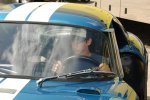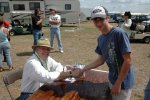In "Fast News from Ford Racing, March 13, 2014, Vol. 7, Issue 11
Looking Back on Ford Racing History at the 12 Hours of Sebring -
View attachment 33207
http://racing.ford.com/series/road-...g--seeking-to-add-to-ford-s-great-histor.html
PRUETT RETURNS TO SEBRING, SEEKS TO ADD TO FORD'S GREAT HISTORY
SHARE THIS
By Team Ford Racing Correspondent
Tucked in an otherwise unheralded and relatively remote area in the middle of South Florida, Sebring International Raceway has produced a powerful allure to the racing world since 1952. The famed road course has drawn hall-of-fame names like A.J. Foyt, Dan Gurney, Juan Manuel Fangio, Lyn St. James and a hall-of-fame sure thing, Ford EcoBoost driver Scott Pruett.
In 1986, Pruett picked up his first win for Ford in the famed 12 Hours of Sebring, teaming with Olympian Decathlon champion Bruce Jenner..
“That was pretty neat,” Pruett recently recalled.
“I was still pretty wet behind the ears as far as this level of racing was concerned, and here I was with an Olympic champion and driving a Ford Mustang for Jack Roush. Of course, like me, Jack was relatively new to sports car racing, too, but he came to it after already creating some waves in drag racing. Me? I was just glad to be here; still am (because) Sebring is full of tradition.”
The “tradition” about which Pruett spoke goes back to a time when Ford and Ferrari fought like cats and dogs to win racing honors especially, as history would later reveal, when late Ford Motor Company Chairman Henry Ford II would be jilted at the corporate wedding chapel, so to speak, after Enzo Ferrari at the last second walked away from a deal that would’ve made the financially ailing Italian automobile maker a part of Ford.
Already having long competed and won in the world of NASCAR, Mr. Ford, who believed racing not only showcased the carmaker’s product but helped to develop innovations for that product, too, then took up Ferrari’s downed gauntlet and born was the Ford GT 40 sports car program -- its sole purpose to compete on the international racing stage, one which Europeans had long owned, especially on American soil at Daytona and Sebring.
If Ferrari was to be headed, it may as well be accomplished first on American soil.
Enlisting the support of Ford engine proponents Carroll Shelby -- to whom sports car racing was life’s blood -- and a pair of good ol’ boys named John Holman and Ralph Moody, whose Ford engines were making magical things happen in both NASCAR and the NHRA, Ford Racing started battling the Europeans on home turf.
As is the case today, two Florida races annually dominated the 1960’s early international sports car racing calendar: The Daytona Continental, now the Rolex 24 At Daytona, and The Sebring 12 hours, now the Mobil 1 Twelve Hours of Sebring Fueled by Fresh From Florida.
Lighting a fuse that would lead to an explosion of memorable sports car racing moments, Texan Lloyd Ruby and co-driver Ken Miles of England won at Daytona in 1965 in a Ford GT40.
In 1966, the Ford GT40 MkII again posted a 1-2-3 finish, “certain winners” Dan Gurney and Jerry Grant in their dark blue Shelby American No. 2 Ford GT40 MkII having dominated the race. Yet, in the final hour and with the Goodyear blimp’s famous lights broadcasting Gurney and Grant as winners, a comfortable cushion over the second-place Ford GT40 MkII X-1 roadster of Miles and Ruby entirely evaporated.
For the first and last time driving in a race an open-top GT40 MkII X-1 roadster, in the race’s final seconds Miles motored past a race-car-pushing Gurney -- who was out of fuel -- for the race win.
In 1967 Mario Andretti and Bruce McLaren introduced the Ford GT40 Mk IV to the competitive world. To this day, the car retains the 12 Hours of Sebring’s greatest winning margin of victory (MOV): 12 laps.
After a series of events forced Ford Motor Company, among other manufacturers, from racing John Wyer and one of his famed Gulf Oil-sponsored, powder-blue Ford GT 40s closed the decade with a final Ford overall win at Sebring -- one that would rank as the carmaker’s final competitive domestic sports car race of any sort for years to come.
Returning in 1985 with a focus on the domestic car market, Jack Roush took the point for Ford, fielding just one car in Sebring’s 1985 12-hour race -- the No. 65 Ford Mustang driven by American Wally Dallenbach Jr. and Canadian John Jones -- and won the GTO class after finishing 6th overall -- 12 laps ahead of its closest GTO-class rival, a Pontiac Firebird.
Demonstrating its domestic sports passenger cars were worldly competitors, Ford and Roush returned to Sebring in 1986, winning that year’s 12-hour race with Pruett and Jenner at the helm of a Mustang, then would again win the GTO classes in 1989 and 1990 with Lincoln-Mercury Cougar XR-7s driven by Wally Dallenbach, Jr. and Dorsey Schroeder in ’89 and Robby Gordon, Lyn St. James and Calvin Fish in ’90.
Although Ford or its Lincoln-Mercury division would in the following years compete at Sebring in the form of engines that powered privately entered prototypes, it wouldn’t be until this year -- 24 years later -- that Ford Racing returned to the famed 3.74-mile, 16-turn facility.
Holding true to the vision of Henry Ford II, Chip Ganassi Racing with Felix Sabates’ No. 01 TelCel Ford EcoBoost Riley Daytona Prototype driven by Scott Pruett and Memo Rojas, along with Michael Shank Racing with Curb/Agajanian’s No. 60 Ford EcoBoost Riley DP, driven by John Pew, Ozz Negri and Justin Wilson, come to Sebring with a desire to win, but not just on the track.
Using an engine built with a majority of parts (70 percent) taken straight from the same manufacturing facilities as the parts found in Ford automobiles throughout the U.S., the two teams, backed by Roush Yates Engines and Ford Racing engineers, transfer what is learned in competition to the production cars -- whether strengthening longevity or increasing fuel mileage.
Today’s electronic monitoring of the twin-turbocharged 3.5 liter Ford EcoBoost engine allows engineers to peek inside the engine as it operates, the provided data pointing to not just the engine’s strong points, but what can be made still stronger; the data pointing not just to that which allows the Ford EcoBoost engine to go farther on a gallon of fuel, but to that which will help it go still farther on that same gallon.
While Ford Racing and its partners ardently wish to win at Sebring or wherever it may compete, in the end it’s the consumer who benefits and, in the eyes of Ford, wins as a result.
Exactly as Henry Ford II would have it.




